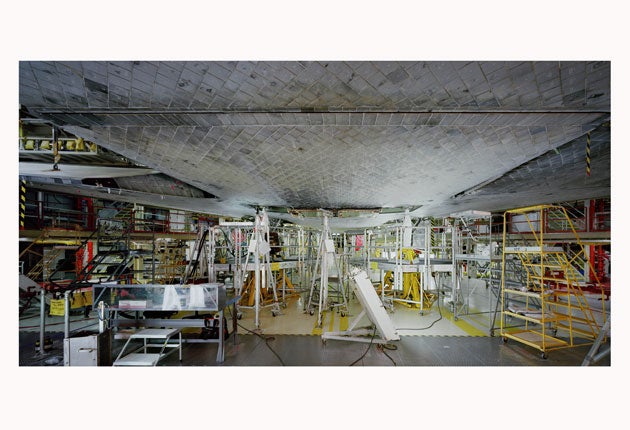Thomas Struth: Photographs 1978–2010, Whitechapel Gallery, London<br/>Vivian Maier: A Life Uncovered, German Gymnasium, London
Where have Thomas Struth's 4m-tall, gargantuan-format series been hiding all these years?

Your support helps us to tell the story
From reproductive rights to climate change to Big Tech, The Independent is on the ground when the story is developing. Whether it's investigating the financials of Elon Musk's pro-Trump PAC or producing our latest documentary, 'The A Word', which shines a light on the American women fighting for reproductive rights, we know how important it is to parse out the facts from the messaging.
At such a critical moment in US history, we need reporters on the ground. Your donation allows us to keep sending journalists to speak to both sides of the story.
The Independent is trusted by Americans across the entire political spectrum. And unlike many other quality news outlets, we choose not to lock Americans out of our reporting and analysis with paywalls. We believe quality journalism should be available to everyone, paid for by those who can afford it.
Your support makes all the difference.The German photographer Thomas Struth makes prints almost as towering as his ambitions for them.
Some are four metres tall, so why haven't we been able to spot them for the past 20 years? Struth, who has just photographed the Queen and the Duke of Edinburgh for a National Portrait Gallery touring exhibition, has drive but lacks urgency, which hasn't helped. This retrospective is a case of much better late than never.
It is not comprehensive – that would require the National Gallery. If you photograph gargantuan-format series that continue over decades, then an 80-work show can only count as a taster. In any case, many of these images are flavourful enough to make a meal in themselves. Struth, the visual gourmet, studied under the famously minimalist Bechers, Bernd and Hilla, and his delight in detail – the spider's web of wires across the Tokyo skyline or the intricate lace of greenery in a Chinese forest – is rigorously disciplined. The size of the images, the breadth of the ideas and the miniaturist's fascination with tiny elements could all have made for sloppiness but, instead, the structure is perfect, the beauty almost architectural.
The eye wanders happily across 1970s New York streets, or the members of a family, or one of several jungles grouped under the ambiguous title "Paradise", as it might range the façade of Notre Dame (he's photographed that, too). Even when Struth peers into the workings of the Kennedy Space Center, he maintains calm amid the barrage of diagonals. I have no idea what calculations it takes to send a man to the Moon, but I'm prepared to believe that if they have a visual equivalent, this is it.
Struth is 56 now, and comfortably famous, which is why he's impelled to question the cultural hierarchy. His best-known images prowl the corridors of the great art institutions, ogling pictures and spectators, and both examining and rewarding the search for knowledge. You do not need to understand Delacroix, the 19th-century struggle for French self-determination that inspired his Liberty Leading the People, or the recent history of Japan in order to enjoy watching the Tokyo National Museum's visitors stare at this Romantic image of plebeian revolt, lit up like a cinema blockbuster. But the more you know, the more you'll get from it. It's as if Struth were photographing enlightenment itself.
The incompleteness of this exhibition is not just inevitable; it's appropriate. In jungles, city streets, museums and living rooms, Struth assembles a whole that is only ever part of the story; this master of metonymy knows that even the most enormous photograph barely constitutes a hint.
Vivian Maier, 1926-2009, was an eccentric nanny working in New York who photographed obsessively even when she couldn't afford to develop her images. Her archive, sold off to pay storage fees, was discovered recently, and this exhibition – part of the London Street Photography Festival – is her first UK outing. It's small but fascinating: an Arbus-ish odyssey among the suspicious and the sad, mostly on 1950s New York streets. There are a few ravishing colour images, but many have disintegrated in storage; a couple of tantalising travel shots; and self-portraits that show a Mary Poppins-alike with a camera instead of a carpet-bag and a talent for self-expression nearly as startling as Mary's. Maier, under-researched and almost undocumented, keeps her lips sealed, although the bald pates, chubby legs and outraged children she photographed say plenty. But then, some forms of nanny magic require a lot of talking; others, thank goodness, don't.
Thomas Struth: Whitechapel Gallery (0844 412 4309) to 16 Sep. 'The Queen: Art and Image' is at the National Gallery, Edinburgh, until 18 Sep. Vivian Maier: German Gymnasium, London NW1, to 24 Jul
Next Week:
Charles Darwent bows to Italian altarpieces at the National Gallery
Art Choice
An unlikely pairing of Cy Twombly – American abstract artist – and Nicolas Poussin – 17th-century French painter – features in Dulwich Picture Gallery's summer show; see if you can make the connection, till 29 Sep. At Tate Liverpool, a major exhibition of René Magritte entitled The Pleasure Principle should be, well, very pleasing indeed (till 16 Oct).
Join our commenting forum
Join thought-provoking conversations, follow other Independent readers and see their replies
Comments